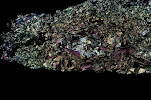If anyone is coming in to this blog in the middle, I direct your attention to the posts I’ve made over the past few days, describing “active reading”, and summarizing my snail’s pace crawl through an article using this technique. It is very, very effective, and I like the amount of information I’m retaining, but it requires a chunk of time. Worth it for me, and perhaps of interest to one or two people out there, which is why I am continuing to post my notes as I make them.
Paragraph 33 describes the two schists from Elijah Ridge, lists the minerals present in each, describes the outcrop of one of them, and specifies which minerals are post-kinematic.
Paragraph 34 mentions an old study (1968) which interpreted the andalusite here as a late Buchan-style overprint, and relates it to an intrusion of a batholith ~50 Ma. Also points out that there is more andalusite to the east of the RLFZ which may be from the same body.
Paragraph 35 describes the deformation visible in these schists.
Paragraph 36 describes the garnet in these schists, and specifies the zoning pattern for garnet in one of the samples.
Paragraph 37 mentions that one of the schists (the kyanite-staurolite one) has plagioclase which has a different (zoned) composition next to the garnet than in the matrix.
Paragraph 38 describes the two occurrences of biotite from one of these schists and mentions that kyanite and sillimanite have been partially replaced by cordierite or andalusite. It also describes the manner in which broken kyanite fragments align with the foliation.
Paragraph 39 contrasts the presence of staurolite in these schists with it rarity in the Skagit Gneiss. It also mentions older studies which estimated P > 6 for staurolite-hornblende coexistence here, and points out that it has suffered brittle deformation along foliation layers.
Paragraph 40 describes the zoning pattern for garnet in the sample which wasn’t covered in paragraph 35 and points to the lovely full-colour garnet maps.
Paragraph 41 describes the plagioclase from the sample which wasn’t discussed in paragraph 37.
Paragraph 42 describes another schist sample.
Paragraph 43 continues the description of that sample, its textures, and alteration.
Here ends the section on Petrography and Mineral Chemistry (though this post summarized only the sub-section of the metapelites from Elijah Ridge). I found the organization within this section to not be as effective as some of the others—it appears to be divided by sample, but there are no additional sub headings to clue that in, and the paragraphs seem to focus on specific mineral(s) making it tough to keep track of which sample is being described where.
The next section will be on Thermometry and Barometry. Stay tuned for tomorrow, when I read and summarize it...
Happy Holidays!
5 days ago




No comments:
Post a Comment